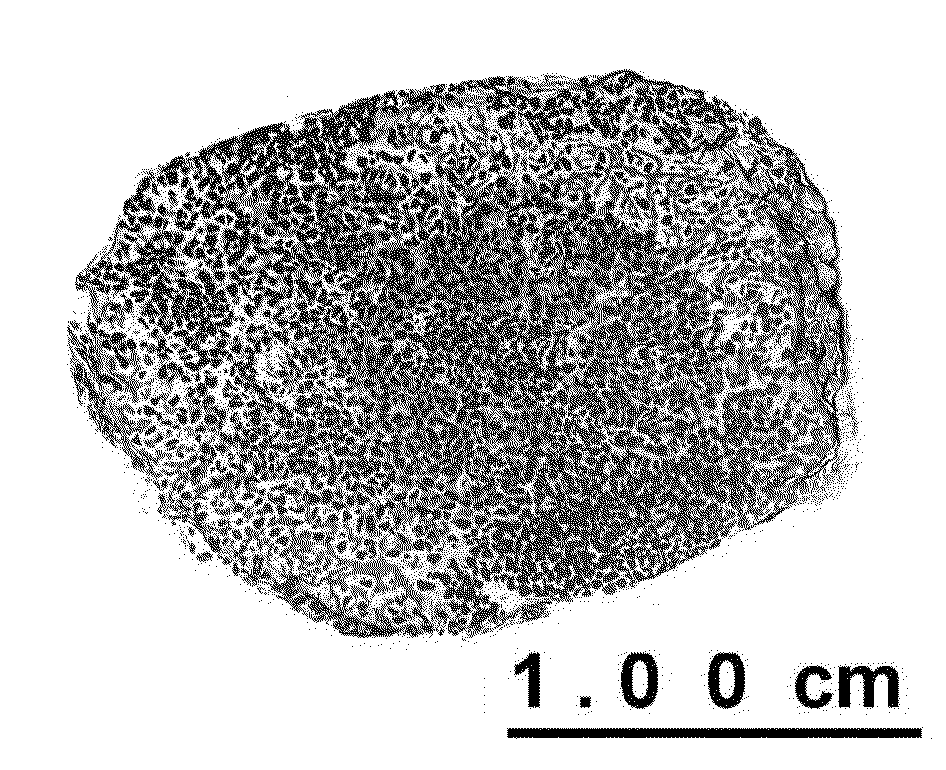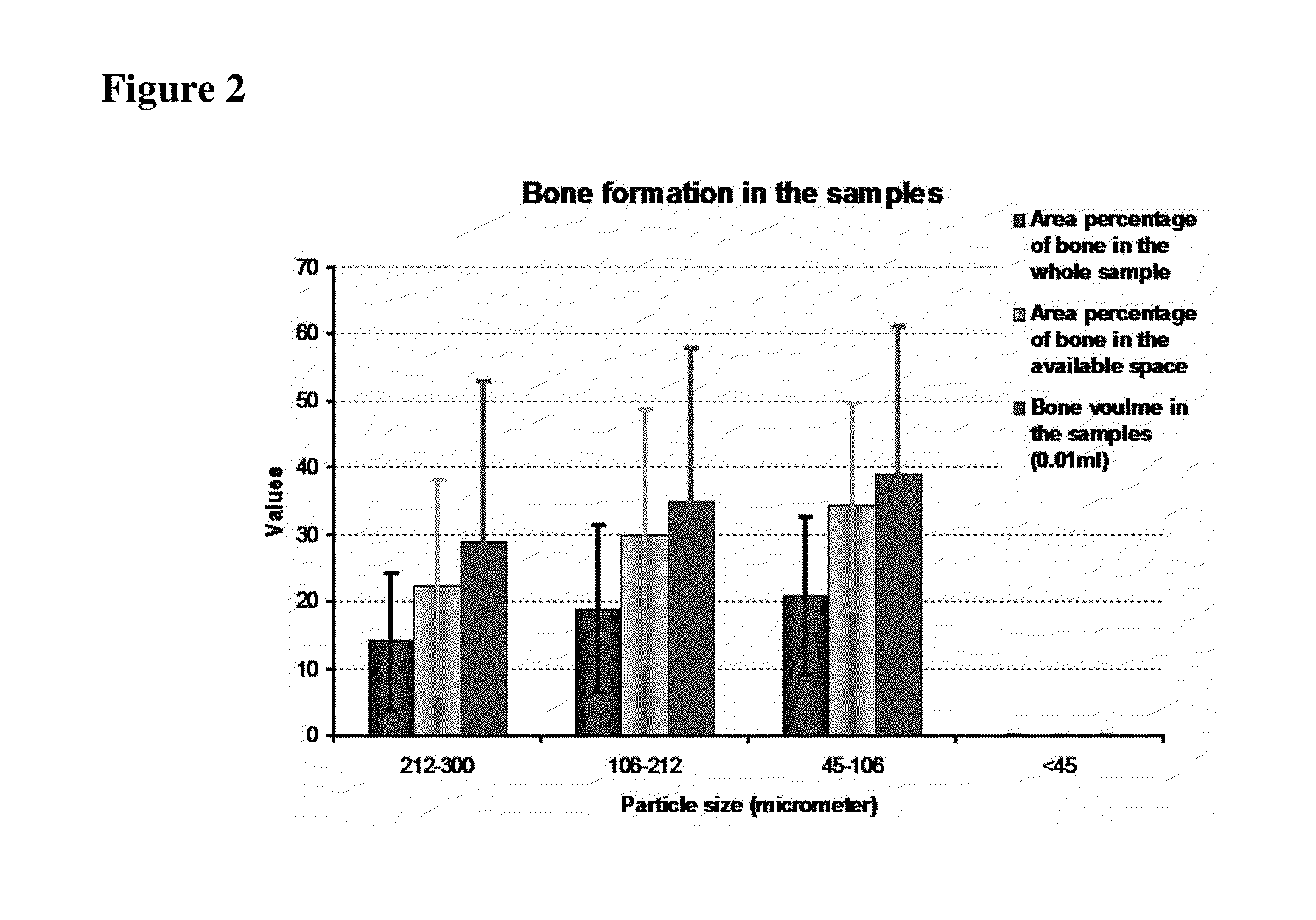Injectable and moldable ceramic materials
a technology of ceramic materials and injection molds, applied in the field of bioactive ceramic materials, can solve the problem of counterintuitive selection of a technology that covers a surfa
- Summary
- Abstract
- Description
- Claims
- Application Information
AI Technical Summary
Benefits of technology
Problems solved by technology
Method used
Image
Examples
example 1
Osteoinduction of Injectable Ceramic Particles In Vivo
[0079]Ceramic particles (biphasic calcium phosphate ceramic, BCP) smaller than 45 μm, 45-106 μm, 106-212 μm and 212-300 μm were prepared with sieves, cleaned ultrasonically, dried and then sterilized.
[0080]Ceramic particles (1000±10 mg per sample) were implanted in the paraspinal muscle of 8 mongrel dogs for 12 weeks to evaluate inductive bone formation. With the permission of the local animal care committee, surgical operation was performed on 8 skeletally mature mongrel dogs (male, 10-15 kg) obtained from a local stock breeder. After anaesthetizing the dogs by an intra-abdominal injection of sodium pentobarbital (30 mg / kg body weight), the back was shaved and the skin was cleaned with iodine. Then a longitudinal incision was made and the paraspinal muscle exposed by blunt separation. Longitudinal muscle incisions were subsequently made by scalpel and muscle pouches were created by blunt separation. Ceramic particles were then p...
example 2
Formulation of Water-Free Carriers with Tailored In Vitro Degradation Characteristics
[0088]In this study, various water-free carrier formulations were developed with the aim of obtaining tailored moldability, injectability, and dissolution kinetics. These formulations were made using raw materials with proven biocompatibility, medical use history, rapid dissolvability, and lubricating effect, as summarized below:[0089]Polyethylene glycol (PEG): PEG400, PEG1000, PEG4000, PEG20000 (e.g., Merck Chemical Industry),[0090]Pluronic®: P65, P84, P85, F87, F88, F98 (e.g., BASF Benelux) and F127 (e.g., Sigma),[0091]Polyol: Glycerol (e.g., Merck Chemical Industry),[0092]Emulsifier: Soya Lecithin (e.g., AMD Special Ingredients),[0093]Carbohydrate: Sucrose (e.g., Sigma Aldrich).
[0094]Formulations were made by mixing two of the above components by volume. Preliminary formulations were screened by their suitability as a particle binder, based on a qualitative handling assessment. Only the positivel...
example 3
In Vivo Efficacy of Three Different Water-Free Carriers
[0099]Various water-free carriers were prepared and combined with TCP granules to form putties as described in Example 2. These formulations were blindly evaluated on the basis of handling characteristics and two out of five were selected for in vivo implantation. These putties were implanted in critical sized defects (19 mm) in the iliac wings of goats for a period of 16 weeks. After explanation, the samples were fixed in formalin, dehydrated using ethanol, and embedded in methyl methacrylate. Calcified sections were made and stained with methylene blue and basic fuchsin solutions to visualize bone formation. Bone formation in the putty samples was compared to that of TCP granules with no carrier—also implanted in the same goats as a control. The experimental design is summarized in Table 2, below.
TABLE 2Study design summary# of test subjectsLocation ofSample formulationimplantedimplant75% P84, 25% F87 putty2Iliac crest90% P85,...
PUM
| Property | Measurement | Unit |
|---|---|---|
| size | aaaaa | aaaaa |
| size | aaaaa | aaaaa |
| porosity | aaaaa | aaaaa |
Abstract
Description
Claims
Application Information
 Login to View More
Login to View More - R&D
- Intellectual Property
- Life Sciences
- Materials
- Tech Scout
- Unparalleled Data Quality
- Higher Quality Content
- 60% Fewer Hallucinations
Browse by: Latest US Patents, China's latest patents, Technical Efficacy Thesaurus, Application Domain, Technology Topic, Popular Technical Reports.
© 2025 PatSnap. All rights reserved.Legal|Privacy policy|Modern Slavery Act Transparency Statement|Sitemap|About US| Contact US: help@patsnap.com



